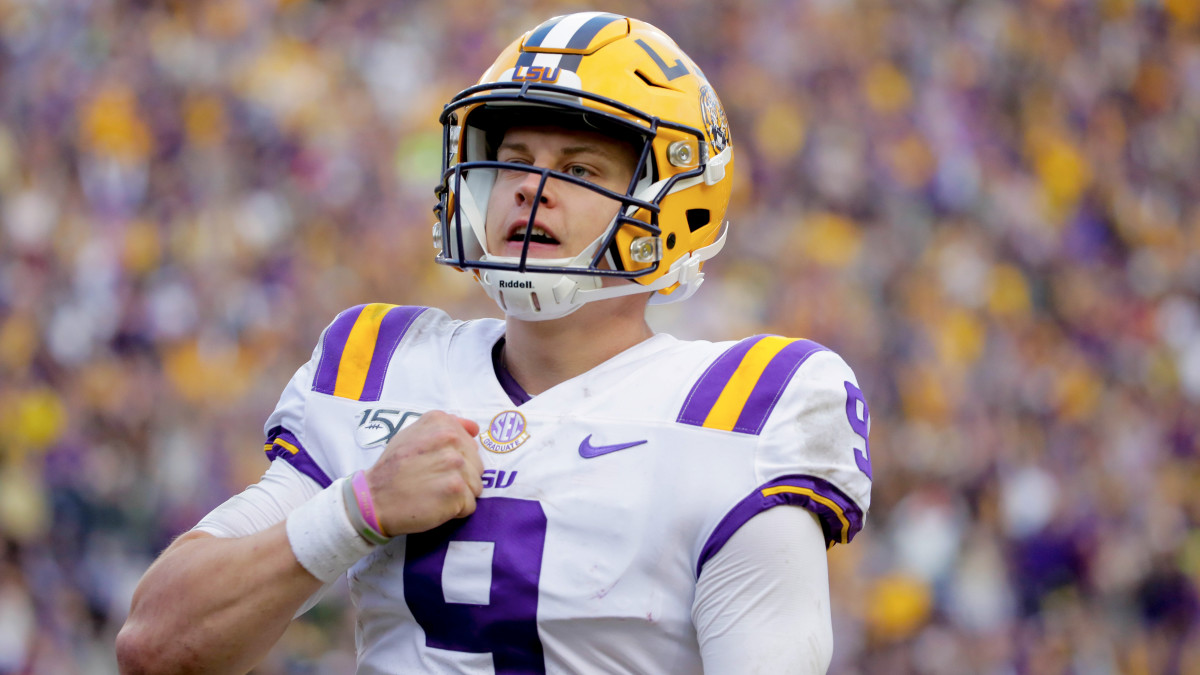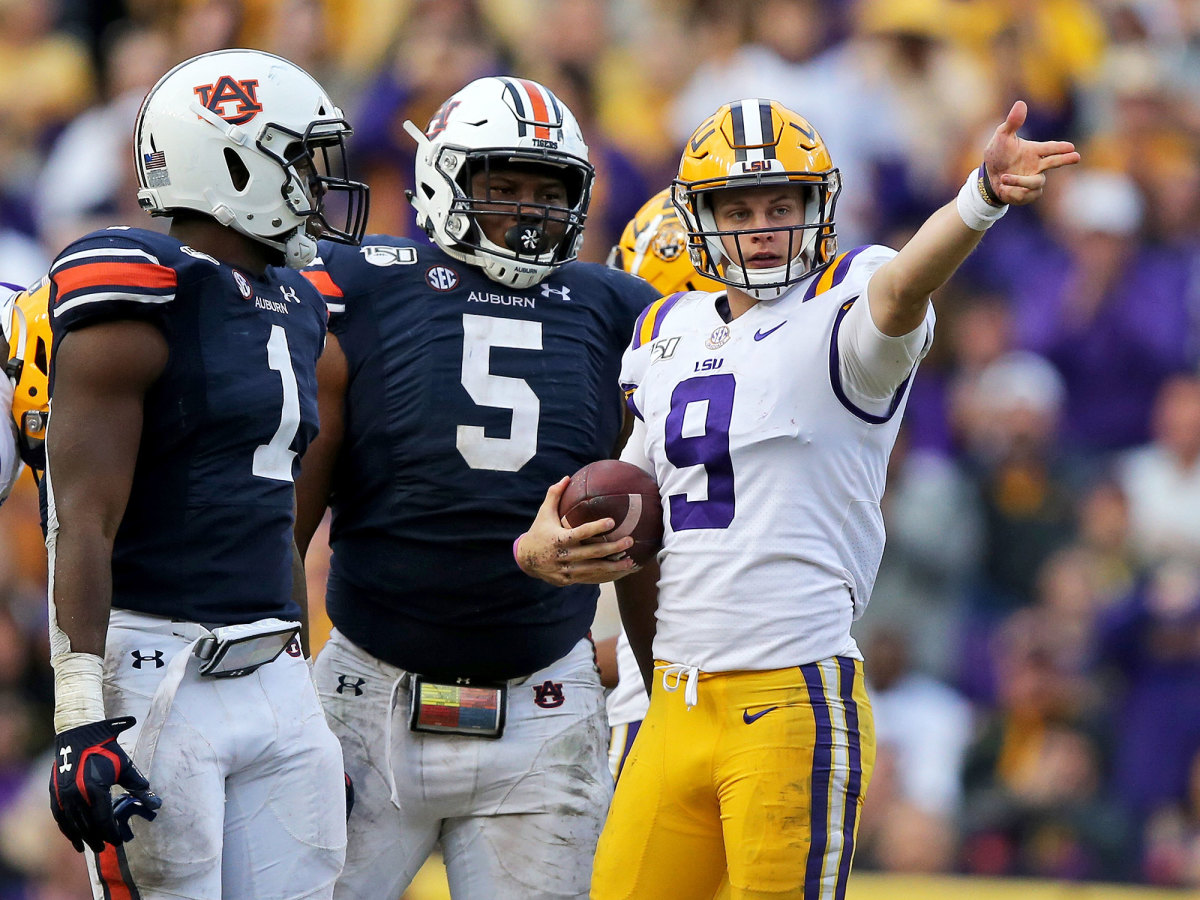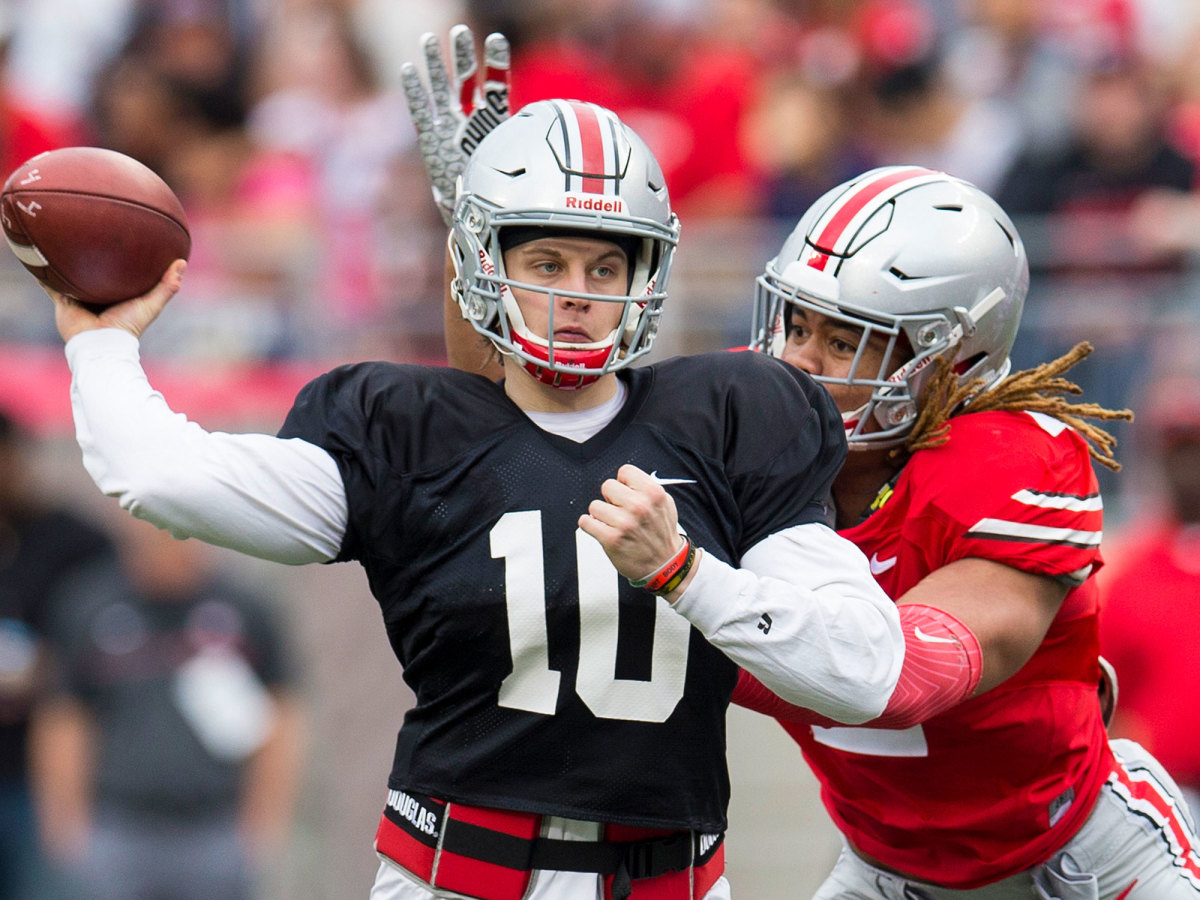Amid Heisman Hype and High Stakes, Joe Burrow Wants Redemption Against Alabama


BATON ROUGE, La. — Joe Burrow is just about to bite into a chicken thigh set on a bed of white rice and slathered in barbecue sauce when a question from someone across the table delays his lunch. He stops, looks up from his plate and gazes toward the questioner with a how in the hell do you know about that look.
He didn’t even tell his mother about this, nor did he tell his brothers, and his father was only briefly aware of it. Just a handful of his LSU teammates really know the full extent of what happened that day in practice when during a goal line drill last November, he tripped and tumbled to the turf, landing on his throwing arm. Crunch. He separated his shoulder.
It was a Thursday. On Saturday, he played against top-ranked Alabama. “Get shot up with a bunch of drugs and go out and play,” he explains. This was not some deceitful Varsity Blues–like ploy by coaches to pressure a player to compete hurt. This was Joe Burrow, already heralded as the toughest man around this town, convincing coaches to let him play in the biggest game of the year. Making matters worse, his backup, Myles Brennan, was injured with a back issue that the program had kept quiet. During a portion of practice that week, Andre Sale, a walk-on, even served as LSU’s No. 1 QB.
“Joe was so tough. I never got to play,” recalls Sale. That Saturday, Burrow suffered his worst loss as a starting quarterback—29–0 at home to the Crimson Tide—but don’t think he’s using the injury as an excuse. “They were just flat-out better than us last year,” he says.
And this year? We’ll find out soon. Almost exactly a year later, Burrow knows this second go-around is not just any other game. It is No. 1 vs. No. 2. It is undefeated vs. undefeated. It is this year’s Heisman Trophy favorite vs. last year’s Heisman Trophy runner-up. It is a program-defining losing skid in Baton Rouge vs. a perennial college football dynasty in Tuscaloosa. It is LSU vs. Alabama. It is big, really, really big—the biggest regular-season game in the sport since they last met as 1-verse-2 in 2011. In the middle of it all is Burrow, until very recently only known to many as the guy who lost the Ohio State starting quarterback job to Dwayne Haskins.
So much has changed for the 6’4”, 215-pound Midwesterner. Let’s recap, shall we? Burrow moved to Baton Rouge in May 2018 after leaving his beloved Buckeyes, claimed the starting job during fall camp, ended last season on an almighty tear, began this year as a 200/1 Heisman longshot and, eight games into the season, is the second-most prolific passer in college football, the most accurate quarterback in the sport and the odds-on favorite to win the top individual prize in the game. His team is not only 8–0 but is also ranked No. 1. “It blows my mind where it started and where we are today,” says Dan Burrow, Joe’s 38-year-old brother who lives in Houston. “You hear about these stories and see them, these kids climbing and climbing. I never in my wildest dreams… I thought he could be here and do it, but it’s mind-blowing for me—he did it. He’s here. It’s real. It’s crazy.”
You don’t have to tell Joey (those close to Joe Burrow add a ‘y’ to his name). Burrow’s life has changed dramatically just in the last eight weeks. As a local celebrity, he can’t frequent many places around Baton Rouge, even stopping his trips to a local casino (he’s a big blackjack player). This has not stopped LSU fans from communicating with their quarterback. “I’ve had a couple people figure out my email from the LSU directory and email me weird stuff,” he says. “It’s like, how do you find my personal email address?” Agents, mostly absent two months ago, are lining up for meetings with Burrow’s father, Jimmy. Scouts, projecting Burrow as at best a fifth-rounder two months ago, are slotting him into the first round. “It’s a little different,” Joe Burrow smiles, “than back in July.”
His rise isn’t as meteoric as it might first appear. After all, this is a kid who signed with Ohio State as a four-star prospect out of Athens High in eastern Ohio. He made the starting quarterback battle with Haskins so close that coaches never actually told him he’d lost the job (it was supposed to extend into the summer before he left). His family has seen this for years. Dan recalls his brother rifling passes with stunning accuracy at age 9, and Jamie Burrow, his oldest brother, remembers leaving Joey’s first college spring game thinking “this kid could be a first-round pick.” Even last year, LSU running back Clyde Edwards-Helaire saw it. “It’s been there,” he says. “It just wasn’t displayed a lot because of the offense we were running.”
Surely you’ve heard by now. A 30-yeard-old wunderkind, Joe Brady, overhauled LSU’s offense this offseason, transforming an archaic scheme into a pass-leaning spread that features two main parts: an RPO system Brady derived while at Penn State under current Mississippi State coach Joe Moorhead and passing concepts he consumed while working with the New Orleans Saints. Sometimes the Tigers use more of one than the other. Sometimes they only use one. It all depends on the defense, says Burrow. “Against Florida, we RPO’ed them the whole game (because) we hadn’t showed it in a couple weeks and they were so good in the secondary,” the quarterback says. “Against Auburn, we were planning on doing the RPO stuff and they came out in a defense we hadn’t seen before. So we went back to our base stuff.”

LSU’s offense is a group of parts that have connected in a transformative way. Brady is meshing with offensive coordinator Steve Ensminger, old enough to be his father. Sophomore receivers Terrace Marshall and J’Marr Chase and veteran Justin Jefferson are fitting snuggly into the scheme. A little-used tight end, Thad Moss, the son of Randy, is blossoming into a big target. But where would this group be without the captain? Burrow is the biggest cog moving one of the most prolific offenses in the sport. Ensminger and Brady trust their quarterback with pre-snap play-calling decisions based on defensive formations. “If I see we have leverage to the boundary, I’ll just give Ja’Marr a different route and we’ll throw that,” Burrow says. “Or if we have a deep route called and they’re playing off, I just check to a shorter route and complete the ball. Stuff like that.”
Enough about Burrow’s statistical climb, Heisman hype and role in the offense—how the heck did he end up in Baton Rouge, Louisiana? Upon leaving Ohio State in spring of 2018, Burrow had plenty of options outside of the two schools—LSU and Cincinnati—that he visited. As a member of the coaching fraternity, Jimmy Burrow, fielded calls from fellow coaches around the nation inquiring about his son’s talents. In a recent interview, he recalls many of the schools that made contact with him: Indiana, Minnesota, Michigan, Alabama, Georgia, North Carolina, LSU, Cincinnati, Tennessee, Arizona State, Vanderbilt, West Virginia and just about every school in the Mid-American Conference. In all, there were about 25.
One of the most surprising on that list was Georgia, which had on its roster entrenched starter Jake Fromm and highly touted freshman Justin Fields. Another surprise on the list: Alabama, which at the time had two good options in Tagovailoa and Jalen Hurts. “People that had quarterbacks called,” Jimmy says. “I understood some of them. You know Joe: He’s not afraid of competition, but if we were going to do that, we’d have stayed at Ohio State.” The Crimson Tide’s recruitment of Joe stretched back years. Longtime Bama assistant Burton Burns and Jimmy are close friends—they played at Nebraska together. Burns tried twice in high school to sign Burrow, the first time in May 2014 by sending Alabama assistant Bobby Williams to Ohio to watch Joe throw. The Buckeyes staff learned of the visit, says Jimmy, and they offered his son soon afterward. “[Alabama] was supposed to get back to me and then that following week is when Coach [Urban] Meyer called and offered,” Jimmy says. “I called Burton, ‘He’s going to Oho State.’”
Months later, as Joe’s senior season began, Burton tried again. “It was too late,” Jimmy says. Then came spring 2018 after Joe announced his transfer. Burns had help this time from then-Alabama quarterbacks coach Dan Enos, who had recruited Joe in 2013–14 while at Central Michigan. Alabama was furiously on the hunt for a transfer quarterback because the Tide expected either Tagovailoa or Hurts to leave before the 2018 season, recalls Joe Burrow. “They wanted me to take a visit. I’m like, ‘I’m not going to be a backup. I’m transferring to play football, not to say I’m the backup for Tua at Alabama.’” Even Dan Burrow heard from the Alabama staff during this time. A Tide graduate assistant and friend called him with a message: “We want to get in on Joe.”
The one school that did not recruit Burrow was the one he kept close to his heart. Joe’s father and two brothers all played at Nebraska. The Cornhuskers never offered or even showed much interest, both in high school and during Joe’s transfer spring. This is still a point of contention for Dan Burrow, a safety for Nebraska at the turn of the century. “They were questioning his arm strength and whatever,” Dan says. “All Joe ever wanted to do is play for Nebraska. It really, really hurt me.” For Dan’s brother, it is motivation—all of it: his childhood team didn’t want him; he never got an invitation to the high school all-star showcase, Elite 11; people doubting his skills, even as recently as this year (see SEC Network’s Jordan Rodgers); and he didn’t win the starting job at Ohio State. “He felt like he won that job,” Dan says. “That really messed with him mentally.”

Despite all of it, Joe is on good terms with his former coaches, one more than all the rest. Urban Meyer still texts Joe before and after nearly every single game. Does he believe Meyer will stay retired? “He’s trying his best to do it. I think he wants to be able to do it. Knowing Coach Meyer… I think it’ll probably last three years,” Joe says. Meanwhile, those in Ohio are rooting for a Buckeyes-Tigers meeting in the College Football Playoff, says Jimmy. Entering this week, Ohio State and LSU have arguably looked the best among any other college football teams. They are winning by a clip of 27 and 40 points, respectively. “It’s hard to not think about it,” Jimmy admits. “It is brought up around here. The people in Ohio, that’s their dream matchup. I’m sure (Joe) would want that too.” The two schools feel like they’re on a collision course. Standing in the way, at least for the Tigers, is an old foe.
Nick Saban has won eight straight games over his old employer, a stretch that began with one of the most infamous events in LSU football lore: the 21–0 defeat to the Tide in the 2011 BCS championship game in New Orleans. It is a moment that many believe altered the course of history, marking the start of the Tide’s reign over the SEC and ending the Tigers’ magical run that began in 2001 by, of all people, Saban.
Scott Woodward, now LSU’s athletic director, attended that game in the Superdome. “After the game, I was like, ‘Ooh, something bad happened,’” says Woodward, an LSU alum who worked with Saban during his time in Baton Rouge. “I didn’t realize it would have the place in time that it did. There’s really a couple of sentinel moments and obviously everyone now on reflection sees that as one of them. LSU wasn’t the same after that. I don’t know if that’s the case, but that’s a lot of folks’ opinion.” Burrow compares the Alabama-LSU series to one he’s more familiar with. Ohio State has beaten Michigan seven consecutive times. “I’m on the other end right now,” he says. “I think we’re a lot better of a football team this year. It’s night-and-day on offense. I just think this year… this feels special for us.”
On Saturday, the stakes are higher for one individual more than any other. Some feel like Burrow has a shot against Alabama to secure the top prize in the sport and become LSU’s first Heisman Trophy winner in exactly 60 years. Burrow and Tagovailoa are among a clear-cut four contenders for the trophy, along with Hurts at Oklahoma and Justin Fields at Ohio State. Is this Tua vs. Joey for all the Heisman marbles? “Not that one game ever determines a player’s entirety of what you think about him, but you do want to see which or both step up,” an NFL scout says. “Just the spectacle of the game can sometimes affect both guys. Some rise up. For some, it’s too much.”
Burrow doesn’t know exactly what to expect from Alabama. During the 29–0 loss last season, the Tide surprised him by playing zone for much of the game. Led by defensive lineman Quinnen Williams, Bama got pressure by rushing four and forced LSU to keep back its tight end and others in pass protection. “We just didn’t have enough people out to attack their zone,” he says. Plenty of defenses this season have thrown a wrinkle at the Tigers and their new-look offense. Auburn tried that 3-1-7 concept. Texas actually did some of that, too. Others have mixed in zone and man-to-man. “We’ve seen something different from every team we’ve played, and nothing has really worked so far,” Burrow says. “We had over 500 yards in just about every game no matter what any team has done. We’re going in for a game plan for what (Alabama) usually does, but we also have our base stuff if we see something different.”
Something different? That was Joe Burrow’s rear end being exposed on national television. In the win at Mississippi State three weeks ago, a defender, while tackling Burrow, yanked his pants down. The quarterback, while falling to the turf and simultaneously holding onto the ball, hoisted the pants back up but not before CBS cameras caught a portion of his behind. To his mother, this was impressive multi-tasking by her son. “He managed it well,” laughs Robin Burrow, an elementary school principal in Ohio. Joe wouldn’t be caught dead strutting around shirtless, let alone pants-less, she says. “Joe has always been a pretty humble kid. He never really liked to play shirts and skins,” says Robin. “There was no way he was going to be a skins. He started doing competitive basketball and they’d always do shirts and skins. He said no. I went and got vests for the team so they wouldn’t have to do shirts and skins.”
Robin is speaking to a reporter during a whirlwind bye week full of interviews. A Washington Post reporter met with her husband earlier in the day, and a Louisiana columnist interviewed both parents. A crew of LSU’s in-house media members spent two days with the family. Back in Baton Rouge, her son is exhausted from the media car wash of the last two months. In fact, last week he turned down an invitation to appear on ESPN College GameDay, along with dozens of other requests. He’s just not that kind of guy. As a Heisman frontrunner, he understands the attention, but he doesn’t have to like it.
During that lunch in Baton Rouge, a television over Burrow’s right shoulder is tuned into a segment featuring ESPN personality Paul Finebaum, known for his antagonistic sound bites. “Interesting dude,” Burrow smiles. Burrow doesn’t follow too much sports media coverage. He’ll sometimes listen to Fox Sports radio personality Colin Cowherd, mostly in bite-sized clips that appear in his social media feed—like the one a few weeks ago when Cowherd, with Meyer on set, embarrassed himself by not knowing that Burrow spent the first three years of college playing for the man before him. When asked about it, Burrow only gives a chuckling nod as confirmation that he’s seen it.
Cowherd’s gaffe encapsulates Burrow’s rise perfectly—there are football fans in America still oblivious of the Heisman frontrunner. That’s O.K. It is just more motivation for the guy some call Joey—the one who played against Alabama a year ago with a separated shoulder. Edwards-Helaire, the LSU tailback, recalls seeing Burrow’s throwing shoulder after that November practice. It was swollen and red. “For him to be like ‘I’ll play it’s cool,’ that’s just him,” Edwards-Helaire says. “Joe has that ‘it’ factor.” That’s the reason so many around the LSU football program believe this particular game against Alabama will end differently than the rest—because of Joey, this time with a healthy throwing shoulder.
